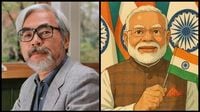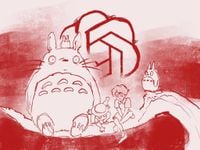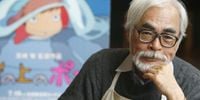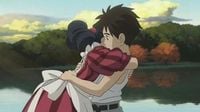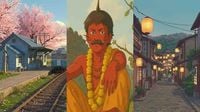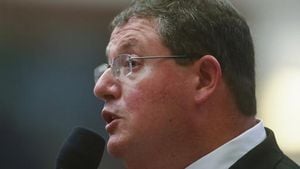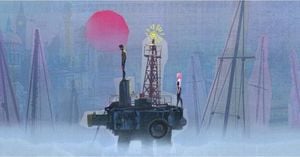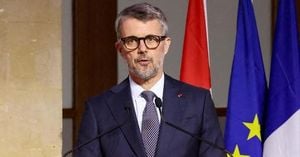The rapid rise of artificial intelligence (AI) has sparked significant debate within the art community, particularly around the recent trend of AI-generated images that mimic the iconic style of Studio Ghibli, the renowned Japanese animation studio. As these images flood social media, the conversation has shifted towards the implications of this technology on artistic integrity and environmental sustainability.
OpenAI's latest image generation tool allows users to create stunning visuals in the style of Studio Ghibli with just a few text prompts. This capability has led to a surge in Ghibli-inspired AI art, captivating fans of the studio's whimsical and deeply emotional storytelling. However, this phenomenon, often referred to as “Ghiblification,” has not come without controversy.
Hayao Miyazaki, co-founder of Studio Ghibli, has been an outspoken critic of AI in art. A clip circulating online features Miyazaki calling AI an “insult to life itself,” reflecting his deep concerns about the emotional depth and human intention that AI-generated art lacks. This perspective resonates with many artists who believe that the essence of art is rooted in human experience and emotion.
As the trend gained momentum, notable organizations, including the Israel Defense Forces (IDF), joined in by posting AI-generated images styled after Ghibli's aesthetic. On March 30, 2025, the IDF's official account shared a series of images depicting soldiers in a whimsical Ghibli style, captioning their post: "We thought we’d also hop on the Ghibli trend." This appropriation sparked outrage among fans and critics alike, who argue that such uses of Ghibli's style misalign with the studio's core values, which emphasize the beauty of nature and the human experience.
Critics assert that the ability to generate images in the style of another artist diminishes the original work's meaning and intent. Traditionally, creating fan art requires a deep understanding of the source material and a dedication to replicating its themes and values. In contrast, AI-generated art can produce visuals instantly, stripping away the appreciation and effort that come with traditional artistic creation.
Moreover, the environmental impact of AI-generated content cannot be overlooked. A study conducted by The Washington Post in collaboration with the University of California, Riverside, revealed that generating a mere 100-word email with OpenAI's GPT-4 model consumes 519 milliliters of water for cooling. This raises questions about the sustainability of technologies that demand vast resources for what some deem frivolous artistic endeavors.
Despite the criticisms, proponents of AI art argue that it democratizes creativity, allowing individuals without technical skills to express their visions. Tools like ChatGPT and its alternatives—Gemini, GrokAI, and Artbreeder—make it easier for anyone to generate high-quality digital art, fostering a broader engagement with artistic expression.
However, the legal landscape surrounding AI-generated art remains murky. Copyright issues are at the forefront, as many artists and creators have begun to challenge the unauthorized use of their work in training AI models. The question arises: can an artistic style be copyrighted? This legal gray area complicates the relationship between traditional artists and the burgeoning field of AI-generated content.
As the debate continues, it is essential to recognize that art does not exist in a vacuum. Miyazaki's own work has drawn inspiration from various sources, including Western animation and Japanese folklore. Thus, while AI may not replicate the unique qualities of Ghibli's art, it does introduce new audiences to the studio's legacy. Supporters argue that AI can serve as a tool to amplify rather than diminish the impact of original works.
Yet, the tension between AI-generated art and traditional artistry is palpable. Many artists feel that the rise of AI threatens their livelihoods and undermines the value of their painstaking efforts. The fear is that as AI becomes more prevalent, the appreciation for human-created art may diminish, leading to a future where art is merely a visual commodity stripped of its narrative depth and cultural significance.
The recent trend of AI-generated Ghibli-style art has sparked a renewed conversation about the role of technology in creative fields. While some see it as a harmless trend, others view it as a troubling indication of a future where art becomes mere decoration, devoid of the emotional and political messages that have historically defined it.
As the art community grapples with these challenges, it is crucial to advocate for ethical practices in AI development and usage. The need for global regulations that address the environmental impact of AI and protect the rights of artists has never been more pressing. The balance between innovation and respect for artistic integrity must be carefully navigated to ensure that the future of art remains rich, meaningful, and true to its human roots.
In conclusion, while AI-generated art may offer new avenues for creativity, it is essential to approach this technology with caution. The artistic landscape is evolving, and as it does, it opens the door to both exciting possibilities and significant challenges that must be thoughtfully addressed.
